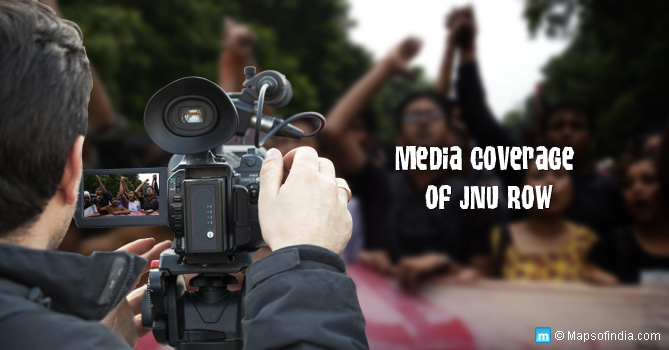The country has once again been polarised on account of the ‘incident’ at JNU on 9 February this year. We have had highly emotive reportage on the incident and all the subsequent action that has followed. At the time of writing this, the issue remains open to heated debate between all stakeholders. But it does raise one important question on the role of media in all this.
The issue isn’t about what happened in JNU but how it was reported and by who, for it has an impact on people’s opinion and reaction. In a country as large as India, which happens to be a cauldron of socio-cultural-religious diversity, there is possibility of dissension and conflict from time-to-time, and democracy remains the best platform to discuss and debate all contentious issues and come up with acceptable solutions through consensus.
Media Coverage of JNU Row
So, when the media – the fourth pillar of democracy – reports an incident like what happened in JNU, it is not the issue itself but the manner of reporting that becomes critical. Reading about an incident can have a very different impact than watching a highly charged and emotional coverage on TV, which can trigger a reaction among people leading to a serious law and order problem.
This can be seen clearly in the JNU coverage and reporting on the Jat agitation for reservation in Haryana. One can witness that media is shifting its role from mere ‘reporting’ from a neutral perspective to offering a verdict on incidents as they happen.
Almost all channels are guilty of this. This is a dangerous trend and India needs to seriously debate this as the consequences can be dangerous. We saw this during the high decibel coverage of the Talwar murder case and also in the Sheena Bora murder case, where the trial by media was stark and out in the open with verdicts being freely given even before the courts had come to any conclusion.
A sharp and watchful media is not only desirable but essential in a country like India, but when the media begins to play Judge and the Hangman, we have a problem and this is why a serious debate on the emerging role and impact of media in a thriving democracy is essential.
Jumping the Gun
TRPs play a significant role in determining the future of a channel and therefore, all channels compete for eyeballs. In the world of news coverage, getting the news first is as critical as what you do with the news afterwards.
The problem really lies not in live reporting, which in most cases is fair and as it happens, but the subsequent dissection of news through highly emotive debates by individuals, and led by a sharply opinionated news anchor, which often ends up influencing a viewer’s opinion.
Rush for ‘Breaking News’
Often we see the media reporting something that is based on ‘unsubstantiated’ news lead and putting it out as ‘Breaking News’. When JNUSU President Kanhaiya Kumar was arrested, channels reported on how he shouted anti-India slogans. Subsequent analysis of media clips show these to be untrue. This did not end here.
One channel went further and quoted an unsubstantiated confidential report of ‘Intelligence Bureau’ that supposedly stated that Umar Khalid, member of the extreme left wing Democratic Students Union and organiser of the event was a JeM member and had visited Pakistan. Totally untrue.
He is a just another student activist holding strong leftist views and fighting for social causes. Whether or not he made seditious slogans is for the courts to decide but the media has already passed a verdict on him and Kanhaiya Kumar and that is the issue.
Needed Balanced Debates
The news channels began to debate the entire controversy on the lines that left those in the debate polarised between supposed anti-nationals and nationalists. And soon, the debate became political with BJP/RSS supporters on one side versus the rest.
Media debates are desirable as long as they are conducted on mature and balanced lines like BBC’s ‘Doha Debates’ or ‘Intelligence²’, where the anchor is a moderator without an opinion, and simply moderates the discussion between ‘for’ and ‘against’ the motion and leaving it for viewers to form their own opinions. That’s not the case in India.
Firebrand debates on television led by emotionally charged news anchors have become the norm and they tend to decide in advance what line they wish to take, muzzling any contrary voices, and influencing the nature and intensity of the debate.
Students’ Take on Media Reportage
The ones most impacted from the coverage of JNU controversy have been the students of the university. They have been vociferous in demanding their right and freedom to protest, as has been the tradition at JNU since inception. The students have also been protesting the trial by media that has made them all seem like anti-nationals.
International Media’s View on JNU Controversy
The international media has been widely covering the JNU story and they don’t paint a rosy picture for India. They have widely written on rising intolerance to views that are contrary to the ruling party’s.
They have also been critical of the sequence of events including the role played by ABVP, the heavy-handed police action, the subsequent charges of sedition on Kanhaiya Kumar, government’s defence of action taken in JNU, and lastly, the local media’s polarised coverage of events. All have dented India’s image internationally.
It’s time for the media to do some serious introspection.
Also Explore :
JNU Row: Kanhaiya Kumar’s Speech After Release – Highlights
Who is Kanhaiya Kumar? Details about JNU row, Accusations & Controversy
National flag to fly at all Central Universities
About Jawaharlal Nehru University, Delhi
Student Movements in India That the Nation Remembers
The Debate over Rising Intolerance in India






